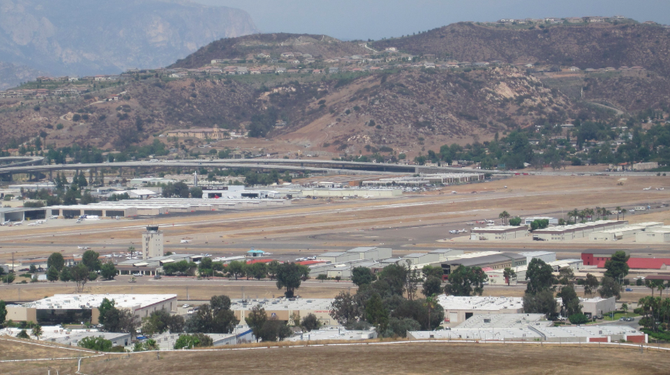 Facebook
Facebook
 X
X
 Instagram
Instagram
 TikTok
TikTok
 Youtube
Youtube

Some Fletcher Hills residents want Gillespie Field airport to consider adopting the Scottsdale Airport pilots’ "Good Neighbor" pledge, a statement that pilots voluntarily sign to declare they are "sensitive" to community concerns such as noise.
Sue Strom, a member of Fletcher Hills residents’ group Advocates for Safe Airport Practices, distributed copies of the Scottsdale pledge at the July 16 Gillespie Development Council meeting. The council represents a joint agreement between the County of San Diego and the City of El Cajon and makes recommendations about the county-owned airport.
At the meeting, airport manager Marc Baskel reported that there were 17,474 operations (landings and take-offs) in May and 14,964 operations during June.
During May and June, there were 23 noise complaints. Baskel said Gillespie's voluntary noise-abatement program was established many years ago and includes pilot education and raising the awareness of residents.
"The [Gillespie Field] good-neighbor program is part of that," Baskel said. According to the Gillespie Field website, the noise-abatement program is coordinated with the FAA. However, the program is "not formally recognized or accepted by the FAA as official air traffic control procedures."
County recommendations include discouraging jet operations and “touch-and-go operations” (when a plane lands and keeps operating before it takes off again) between 10 p.m. and 7 a.m. Furthermore, the program encourages training operations at other airports.
Gillespie Development Council representative Barry Bardack and Strom elaborated on issues discussed at the meeting during separate interviews this week.
Bardack, whose aviation experience includes work as a chief flight instructor and aerospace engineer, has served on the council for six years. As part of the good-neighbor program he helped institute, he said that when pilots reach “pattern altitude” of 1200 feet mean sea level, they reduce power to 2300 RPM to lessen noise.
At the meeting, Fletcher Hills resident David Brittain gave the council a scroll detailing incidents he charted when pilots took off within 22 seconds of each other.
"That's normal," said Bardack. "That's plenty of distance." Bardack noted that Fletcher Hills homeowners sign an agreement acknowledging that they live near an airport.
Strom has lived in Fletcher Hills since 1977 and said the airport has changed since then.
"It was a general aviation mom-and-pop operation, not an aviation center with international flight schools," she said. Strom called the county good-neighbor program "unneighborly" and maintained there is no noise abatement. She said residents' concerns included a fear that development will bring more flight schools.
"We're striving to have a two-way dialogue," Strom said. "Let's start with the [Scottsdale] pledge.” She added that Gillespie Field airport manager Baskel created it when he worked at the Scottsdale airport.


Some Fletcher Hills residents want Gillespie Field airport to consider adopting the Scottsdale Airport pilots’ "Good Neighbor" pledge, a statement that pilots voluntarily sign to declare they are "sensitive" to community concerns such as noise.
Sue Strom, a member of Fletcher Hills residents’ group Advocates for Safe Airport Practices, distributed copies of the Scottsdale pledge at the July 16 Gillespie Development Council meeting. The council represents a joint agreement between the County of San Diego and the City of El Cajon and makes recommendations about the county-owned airport.
At the meeting, airport manager Marc Baskel reported that there were 17,474 operations (landings and take-offs) in May and 14,964 operations during June.
During May and June, there were 23 noise complaints. Baskel said Gillespie's voluntary noise-abatement program was established many years ago and includes pilot education and raising the awareness of residents.
"The [Gillespie Field] good-neighbor program is part of that," Baskel said. According to the Gillespie Field website, the noise-abatement program is coordinated with the FAA. However, the program is "not formally recognized or accepted by the FAA as official air traffic control procedures."
County recommendations include discouraging jet operations and “touch-and-go operations” (when a plane lands and keeps operating before it takes off again) between 10 p.m. and 7 a.m. Furthermore, the program encourages training operations at other airports.
Gillespie Development Council representative Barry Bardack and Strom elaborated on issues discussed at the meeting during separate interviews this week.
Bardack, whose aviation experience includes work as a chief flight instructor and aerospace engineer, has served on the council for six years. As part of the good-neighbor program he helped institute, he said that when pilots reach “pattern altitude” of 1200 feet mean sea level, they reduce power to 2300 RPM to lessen noise.
At the meeting, Fletcher Hills resident David Brittain gave the council a scroll detailing incidents he charted when pilots took off within 22 seconds of each other.
"That's normal," said Bardack. "That's plenty of distance." Bardack noted that Fletcher Hills homeowners sign an agreement acknowledging that they live near an airport.
Strom has lived in Fletcher Hills since 1977 and said the airport has changed since then.
"It was a general aviation mom-and-pop operation, not an aviation center with international flight schools," she said. Strom called the county good-neighbor program "unneighborly" and maintained there is no noise abatement. She said residents' concerns included a fear that development will bring more flight schools.
"We're striving to have a two-way dialogue," Strom said. "Let's start with the [Scottsdale] pledge.” She added that Gillespie Field airport manager Baskel created it when he worked at the Scottsdale airport.
Comments